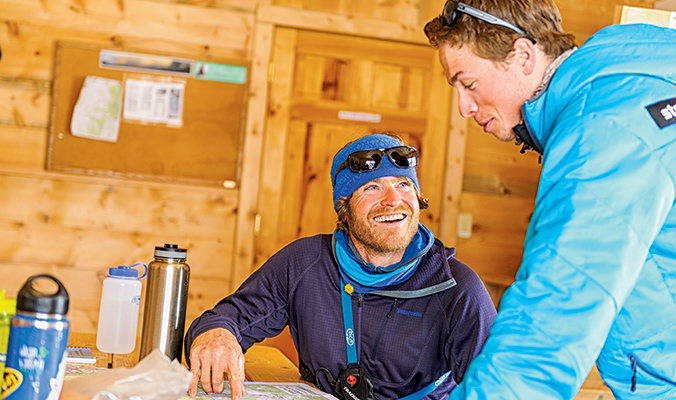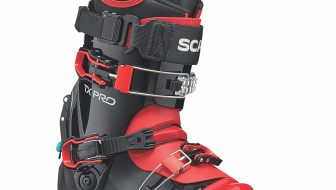When Ryan Koupal first visited the China/Kyrgyzstan border in 1999, he was deeply intrigued by the rugged, remote Tien Shan Mountains. So, after graduating in 2003 with a degree in Mandarin Chinese from Middlebury College, he returned to the Tien Shan while leading programs for Where There Be Dragons, a study-abroad program for high school and college students.
A longtime snowboarder, Koupal merged his two passions in 2010 when he founded 40 Tribes Backcountry Adventures, a guiding operation based in Kyrgyzstan. For the last five seasons, he’s spent nearly two months in Central Asia, organizing backcountry trips for international clients alongside Kyrgyz locals, Canadian splitboard guide Greg Johnson and ski mountaineering legend Ptor Spricenieks.
In 2014, we caught up with Koupal in Colorado’s Berthoud Pass backcountry after he returned to his Boulder home from two months in Kyrgyzstan’s Tien Shan Mountains.
Ryan Koupal: I spent some time on the Kyrgyz/Chinese boarder a long time ago—I stayed in a Kygryz yurt settlement in far Western China back when I was a student in a Where There Be Dragons summer program. I was totally blown away by how wild Western China was. We were on the western side of the Tien Shan Mountains, and I wanted to get in there and see what really was going on.
BCM: What’s the significance of the name, 40 Tribes?
RK: There are a couple stories regarding the origins of the Kyrgyz people. In Kyrgyzstan they have an oral epic called Manas, and Manas is their national hero. The story is that he united the 40 tribes of the area to defend their homeland against invading Chinese.
BCM: What are the mountains and the snow like where you’re operating?
RK: It’s a lot like Colorado in the sense that it’s a continental climate, and geographically it’s very similar to Colorado. You have super dry areas and then areas that are just caked with snow. Average elevation is, I believe, somewhere around 3,000 meters. What we get in our zone is lake-effect snow because we’re right at the edge of Issyk Kul Lake, which is the second largest alpine lake in the world.
BCM: Tell me about your involvement with the local people.
RK: We’ve established a partnership with a village that sits right at the base of the mountain we operate in called Ichke-Jergez. We chose this spot because of the location of the village and the direct, pretty-easy access it offers to the mountains. The villagers use the mountains year round for gathering firewood and hunting, so we run into them a lot in the mountains. They stop in to the yurts for tea and stuff like that. In the yurts we do a full-on, traditional Kyrgyz menu. It’s pretty meat heavy—lots of mutton and potatoes.
We have two local guys who live with us season-long at the yurts to help run the show. We do the guiding, and those guys help do everything around the yurts. One of the guys is from the village, and we use his home as our home-stay. Clients come in and, night one, we do a home stay with them.
For more photos from Kyrgyzstan, follow @40tribes on Instagram.
BCM: Where are most of your clients coming from? Are they looking just for good snow or a wild, totally different experience?
RK: Both. People are just starting to hear about this place and, especially from Europe, it’s becoming a popular travel destination. Kyrgyzstan has done a lot to boost their tourism industry, and that’s critical right now to their economy. They’ve opened up their visa policies and most nationalities can come and stay now, visa-free, for 60 days. As far as our clientele goes, it’s mostly European. We’ve had a lot of Kiwis, a few Aussies, very few from North America.
BCM: Tell me about the hardboot snowboard setup you’re on.
RK: It’s a super-unique setup but starting to catch on. The idea is that, in a hardboot setup, you’re much more set up for what splitboarding can entail: a lot of touring, actually skiing on your splitboard skis, kicking steps, wearing crampons, doing the whole ski mountaineering thing. I got on a hardboot setup back in 2006, really early on when there wasn’t much hardboot gear available. Then I linked up with some guys here in Colorado at Phantom Splitboard Bindings who are really working to advance hardboot splitboard technology.
BCM: When you’re not in Krygyztan for those two months, what else are you doing?
RK: It keeps me busy year round. I’m handing all aspects of the company, doing all the administrative stuff, doing all the marketing, basically everything outside the on-the-ground stuff that’s handled by our local partners. We just went over this past fall to scout the rivers and we may, starting as early as this fall, start working on the fly fishing side of things. It wouldn’t be yurt based but more like a rugged, overland journey.
For more on Ryan Koupal’s 40 Tribes Backcountry Adventures, visit 40tribesbackcountry.com.











That’s amazing there is an advanced ancient civilization buried under the lake and that the location was a prominent way-point on the silk road. travel there from Europe seems a historical trend. now that unesco has taken to protecting the biodiversity of the world’s 10th largest lake since 2000, business could be good for koubal. excavation of that civilization under the lake ought to be cool. i’d love to see a project to benefit the local community, culture, and heritage take shape partnered with 40 tribes in this culturally rich and intriguing location.